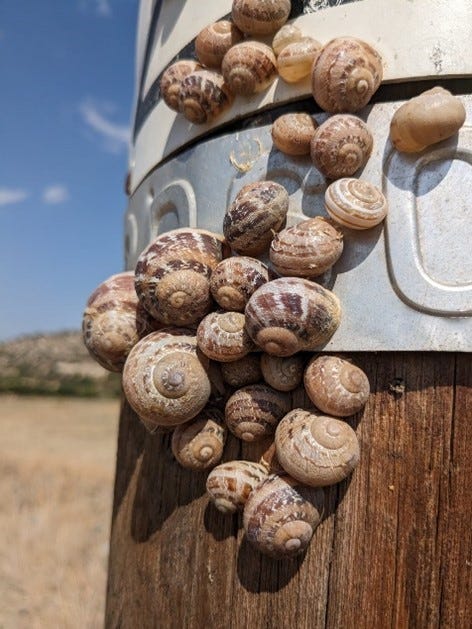Dear friends,
I was jogging in the valley below my house a few days ago when I saw something that surprised me: several dozen snails clustered on a telegraph pole.
I stopped running and climbed onto a rock to examine them. The snails were clumped more tightly together than I would have thought possible, given the way their hard shells keep their soft bodies separate. They were two and a half metres from the ground, clinging to the Danger of Death sign.


Looking at the snails on the wooden pole, I wondered whether I was witnessing a moment of community, competition, conflict or something else entirely. I guessed they were enjoying the heat of the sun-warmed metal, the warmth of being so close to one another. But I wondered why they’d left themselves so exposed. They were vulnerable up there, far too visible to the songbirds, crows and hawks. And what would they eat? Had they mistaken the bare trunk for a tree and presumed that if they kept climbing they would eventually find its branches and leaves? Why had they all gone up there together? Did one of them climb the pole first and the rest of them follow? Or was this a massed group manoeuvre?
One of the things I like most about living in an unfamiliar place are the regular shocks of incomprehension, the reminders of how little I know about the life around me. Jogging around the valley, a sandstone landscape that was once a seafloor and was more recently a riverbed and is now a dammed expanse of fruit trees and fly tipping and creatures who don’t behave the way I expect them to, I experience a bewilderment that feels rich and fresh compared to the settled ignorance I have in the UK, in cities, where I find it normal and unremarkable to know next to nothing about the more-than-human networks I exist within, where I forget that I am part of those networks at all.
Pausing by the telegraph pole, I found it strange to see so many snails together and realised that I’m used not just to seeing them alone, but to seeing them as symbols of solitary independence, travelling away from one another with their homes on their backs. Yet here was this big snail family or community or gathering.
Looking at them, I realised that I know nothing about how snails behave or how they live together. I don’t know how snails communicate. I don’t know how they have sex, whether they have partners or families, or whether they have a home they return to, other than their shell.
As I sketch ideas for a project about care, I’m thinking a lot about the relationship between how, and how well, we know something and how, and how much, we care about it. I’m interested in the way that different kinds of knowing can lead to different kinds of care.
I don’t know anything about snails and I don’t really care about them. And by extension I don’t really care about most things that operate at snail-scale. But I care a bit more now, having stopped to look at them and think about them.
It’s hard to really care for anyone or anything unless that care is twinned with knowledge of and about them. And, conversely, it’s hard not to care about someone or something when we do really know them.
By most standards, my encounter with these snails was one of the smallest things to happen to me in recent days. By another set of standards, it was one of the biggest.
I didn’t intend to write about snails in this letter. I was just going to mention them and then write about my first experiences working in the field of care. But it seems that I have written about snails and I’ll write about that another time.
Warm wishes,
Matt


Your thoughts about pace / scale remind me of The Overstory by Richard Powers - I’m sure you’ll know it - and getting us to think on tree time encourages greater empathy with plants. There’s a real connection between sense of scale and empathy
Wonderful! Thanks Matt. Fabulous pictures too. I can recommend the book SNAIL by Peter Williams – father of old friend Tom Williams. https://reaktionbooks.co.uk/work/snail Peter is a GP and former President of the Medical Defence Union, but he's also obsessed with snails. There's a species named after him.